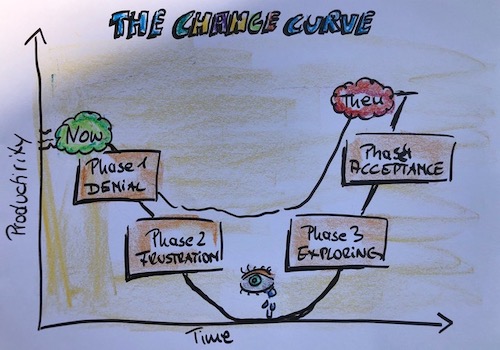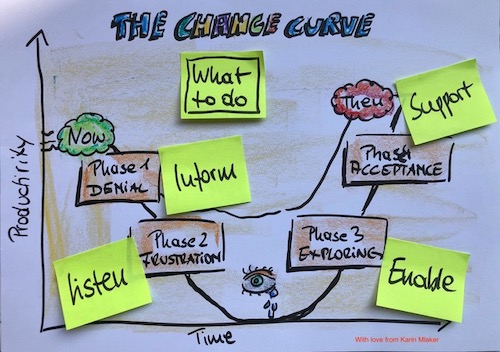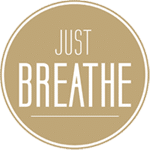Change Curve: How to Deal With a World in Constant Shift

© Phil Child
I was introduced to the Change Curve when involved with re-engineering a business model, back in my corporate day. A popular and powerful tool, it is used to help understand the various stages that a person transitions during times of change.
The Change Curve gives insights into the different phases of emotions that a person goes through and is especially useful when the change is one that one has not oneself instigated. I think we can all agree that the Coronavirus (CV) ticks that box.
Change most normally involves feeling stuck and frustrated and to arrive at a place of feeling empowered and sensing possibilities instead. Yet during this process we want to acknowledge our feelings and to understand their root.
What is the Change Curve?
The original Change Curve was created by Elisabeth Kübler-Ross in 1969. A pioneer in the study of death and dying, she helped revolutionise the care of people with a terminal illness and the stages that they go through as they deal with the news.
The model based on her work has become a popular and powerful tool for understanding stages of any type of personal or organisational change or transition.
Here are the four phases:
- Denial
- Frustration
- Exploration
- Acceptance

Managers can use the Change Curve to tailor approaches and effective communication to individuals dealing with an imposed change. It can help employees transition successfully. But anyone wanting to help another, or themselves, ‘get through’ a period of change can use the Change Curve to better understand in which phase they are at any given moment. Pinpointing the phase can help see what is going on at that particular time, and how to move from resisting change to embracing it. To me this has everything to do with accepting that one is moving through a Change Curve, and to see that one has the choice to leave behind emotions that no longer serve.
Everyone needs their own particular length of time to progress through the curve, which can seem like multiple curves. Some pass through quickly, whereas others take years. In any case, the tool offers support and help.
More on each phase of the Change Curve
Denial
The moment the news of an unexpected change is received, the natural reaction is to deny the need for the particular change. This can go as far as denying what is happening altogether. Phrases typically used to deny the need for change are “It won’t work here”, “We have tried it before” and “Why is this happening to me?”, but there are many different variations that people verbalise or think.
My reflection:
During these CV days, we are challenged to dig a lot deeper than we may be used to. Accomplished in the world, we are used to accepting and implementing changes that affect specific parts of our lives. But what we are now experiencing on a collective level goes beyond the business or private spheres and has implications for the world at large. This is no ‘Business as Usual’. What has been upon us for months, I think we all agree, will probably impact us for some time to come, and denying what is happening will only keep us in a state of suffering. Remembering the ‘perfect past’ will only keep us stuck, as will distracting ourselves with incessant handwashing and news-reading. Instead, we need to ask ourselves, what in this is actually a positive change for me? It will feel counter-intuitive and perhaps made up by the mind, but it can help one accept and move out of denial.
Frustration (& Anger)
Having understood that a change is not going to go away, but will need to be lived through, unable to see a way out of the situation, a person will often resort to feeling frustration, anger and/or bitterness. During this phase people do not know who to blame and may vent their frustration on people or things not related to the change.
My reflection:

To move away from the kind of anger and frustration that most of the collective will be feeling stuck in during these CV-times, we need to trust in different channels of communication to those of the mainstream. We can dwell in frustration and anger and find temporary and illusory relief. By doing so, we will feel that we are a part of the whole, but it will eat us up from the inside. These states of being induce a low vibration that will attract more of the same. This will not allow us to transcend and will negatively impact our health. Sharing one’s feelings with others can help one get out of feeling stuck or pulled down and angry. Friends and networks can offer support as one moves on along the Change Curve, because move we will. Key is: Not to fear crying if one feels like crying! Instead: Release! And challenge the assumption that what CV brings is ‘all bad’.
Exploration
Starting to accept the changes, people most often begin to see that there are new possibilities attached to the change. They start to understand that the change is here to stay, and often try to compromise for a favourable outcome. Comments like “What if we do this?” and similar are common during this phase, as people start to look for any additional information that can improve their understanding of how things may work – given the change.
My reflection:
Usually we are looking at project timelines and try to encourage involvement and for people to see what they can do to start to explore solutions in earnest, but in these trying CV-times we are not looking at any old project; we are looking at our lives. The immensity of the task at hand can be paralysing. Here and now, it seems unfathomable what is going on. The kind of change that is upon us, most of us have never experienced before. But what if some of the basics still apply?

Moving along, we can research solutions, and find practical daily practices and implement them. And we can journal or in other ways keep track of our progress. Just because it is not ‘normal’ it doesn’t need to be ‘fluffy’.
Acceptance
This, the final stage of the Change Curve, is all to do with recognition. As people understand what is happening and embrace it, they are able to commit to the change. This is where most feel the return of the wish to proactively contribute to shaping their new future.
My reflection:
Once we have accepted the situation that we are in we can proactively work with what we have and where we are at. This is all to do with taking the learning from the above phases and being consistent. Am I reverting back to reading news that only upsets me? Am I surrounding myself with people who stay in fear and resistance? In order to create good feedback mechanisms and foster input that can continue to help me move forward in a positive way, I need to wisely choose the people that I surround myself with. Also, I need to celebrate my successes. Accepting our new collective CV-reality doesn’t mean that I accept “all is bad and this is the end of the world”. It is better to see that I can still be joyful and can grow – personally and work wise – in ways that I may never even have imagined before.
Some CV conclusions
Given the distinctive phases of the Change Curve, if you are working to support another you want to be mindful of the ways in which you speak. Clearly, somebody in the phase of Denial or a.k.a. “The Valley of Tears” will not even be able to hear your excitement about the future. Or if they can hear, they will reject everything you say or do. If you take feedback as personal criticism, you may be in for frustrating conversations resulting in exactly the opposite of what you intend!

My three tips:
- Find out in which stage of the Change Curve the person is. Recognize where you are.
- Adjust your conversation to the needs of that person.
- Phase 1: Share factual information. Stay away from conspiracy.
- Phase 2: Simply listen from your heart and refrain from offering solutions or wanting to fix.
- Phase 3: Offer suggestions to encourage the person to try out different things. Avoid being too prescriptive.
- Phase 4: Offer or provide practical support. Help is often accepted with open arms.
- Stay present during your conversation and don’t take negative feedback personally.
Fact is that change is messy and is here to stay! This used to be my mantra in business and now it is literally everywhere.
Change brings vulnerability! In my next article, before I take a summer break of silence and reflection, will be about looking at vulnerability as strength. In short, I will explore how, with the right mindset, being vulnerable can be hugely empowering.
Go with the flow & move towards & beyond acceptance,
Claudia
p.s. If you want to participate in conversations which literally shifting reality, join us for our regular Coffee Morning Live each Friday (register HERE).
More about Claudia Roth
Following a corporate high-profile career in luxury hospitality, my mission is to help those who want to live a more connected and soulful life.
I write, facilitate events and consult companies on the evolution of wellbeing and healing hospitality. My book, “A 28 Days Journey to Self Love”, a guided journal, is available on Amazon and from other major book retailers.
Something more hands-on, I also practice Quantum Energy Coaching, helping my clients transform outdated beliefs for a happier life.
As a heads up I am launching a new initiative “Real Stories by Real People” via Zoom. Everybody is welcomed to a collective space of learning, sharing of wisdom and compassion as we each navigate our life.
All original material copyright © 2020 Claudia Roth


